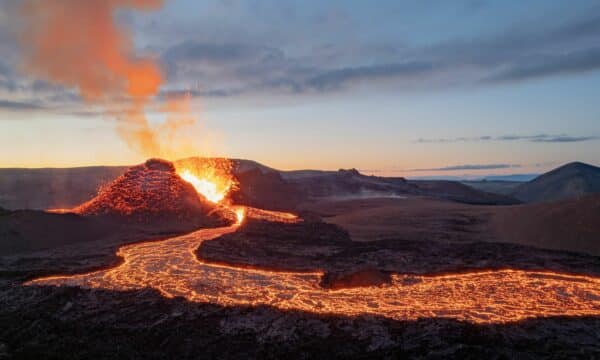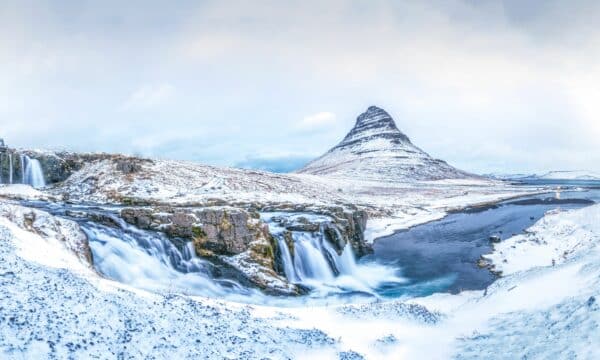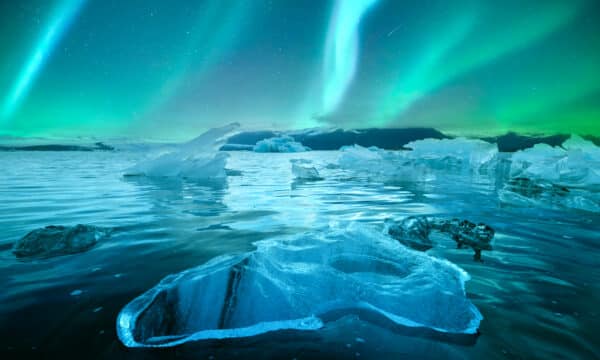What makes the Reykjanes Peninsula so Unique?
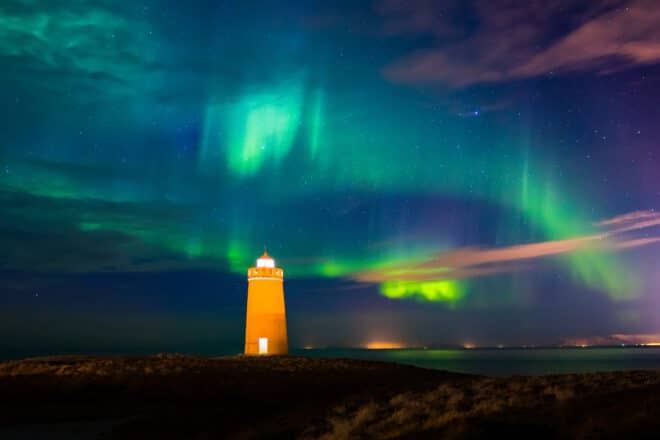
When it comes to Iceland, the Reykjanes Peninsula stands as a hidden gem, often overlooked by visitors who are captivated by the country’s more popular attractions. Yet, what makes this place so unique is its vibrant blend of natural wonders and cultural heritage.
As most visitors to this country arrive at Keflavík Airport, located on the Reykjanes Peninsula, they unknowingly find themselves in the midst of a breathtaking landscape. From the striking geothermal areas like the Blue Lagoon to the dramatic coastline adorned with volcanic cliffs and rugged lava fields, the Reykjanes Peninsula offers a captivating display of Iceland’s raw beauty.
Moreover, this region is steeped in history, with its quaint fishing villages and historic sites that tell tales of the country’s rich Viking past. So, while many may hurry past this enchanting area, those who take the time to explore the Reykjanes Peninsula will uncover a world of wonders that truly sets it apart.
Tectonic Plates & Reykjanes Eruptions
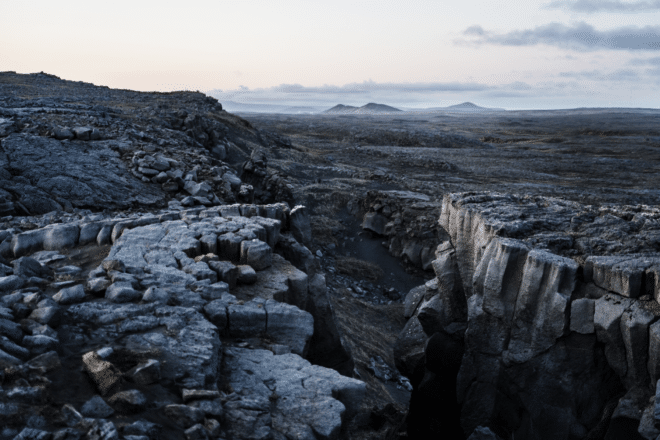
In the realm of geological wonders, few locations capture the imagination quite like the Reykjanes Peninsula. Nestled along the Mid-Atlantic Rift, this captivating stretch of land serves as a testament to the powerful forces that shape our planet.
At its core, the Reykjanes Peninsula is a meeting point for two tectonic plates—the Eurasian and North American plates. These mighty continental plates are gradually drifting apart, creating a landscape that is both breathtaking and volatile.
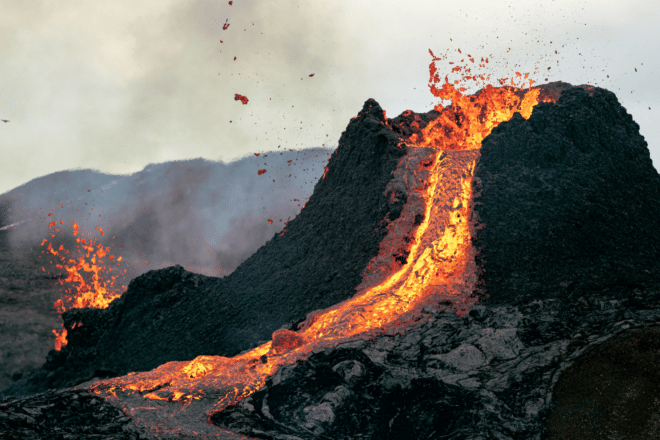
This unique geological positioning has profound implications for the volcanic and geothermal activity in the area. The moving tectonic plates create fractures in the Earth’s crust. This allows magma and heated water to rise to the surface, creating numerous hot springs and steam vents that dot this rugged terrain, as well as volcanoes.
Still today, the Reykjanes Peninsula bears witness to the birth of new land as the diverging plates give rise to volcanic eruptions. Such as the 2021 – 2023 eruptions near Fagradalsfjall Volcano. These events, spectacles of molten lava and billowing smoke, serve as a vivid reminder of the dynamic nature of our planet and the immense power that lies beneath its surface.
11 Best Places to Visit on the Reykjanes Peninsula
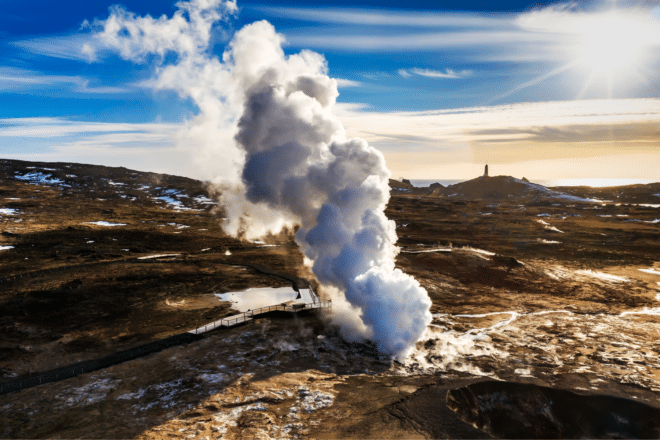
With its proximity to Keflavik International Airport, Reykjanes Peninsula is the perfect starting point to dive into Iceland’s geological wonders. Here, you can explore endless lava fields, unwind in the relaxing Blue Lagoon, and sometimes even witness volcanic eruptions firsthand.
1. Fagradalsfjall Volcano Eruption Sites
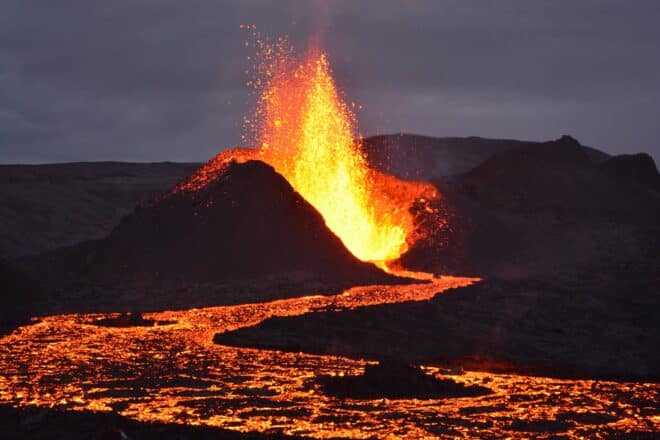
After landing in Iceland, you journey from Keflavík Airport to Reykjavík, driving across an ancient lava field that bears witness to the Reykjanes Peninsula’s fiery past. You see, this region was a vibrant and dynamic volcanic active zone thousands of years ago, with periods of eruptions every 800 – 1000 years.
As of late, Mother Nature has been shaking off her slumber. After centuries of rest since 1240 AD, the Reykjanes Volcanic system has returned to its dynamic state. Ushering in a new era of volcanic activity that could last for years, even centuries.
The volcanic giant first awoke in 2021 with the eruption of Fagradalsfjall Volcano, which lasted roughly six months. Barely a year later, another eruption unfurled in the nearby Geldingadalir Valley. In late 2023, the eruption moved a little East to an area called Sundhnúkagígar, where it regularly erupts every few months.
If the volcano is erupting, you can witness it yourself on an easy helicopter tour. You’ll soar above the majestic landscape and get a bird’s-eye view of the molten lava spewing from the earth’s core.
Even if you visit Iceland when the volcano isn’t erupting, a helicopter tour offers an incredible opportunity to explore the raw beauty of the Reykjanes Peninsula and experience the aftermath of a volcanic eruption firsthand.
2. Kleifarvatn Lake
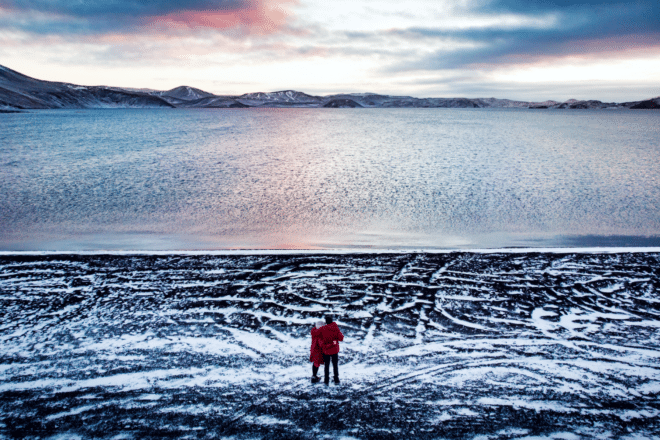
Though it is the largest lake on the peninsula, Kleifarvatn is an underrated and often overlooked gem. No rivers flow into or out of it. Its existence hangs on the delicate balance of precipitation and groundwater flow, and the secretive, underground channels that silently refresh it. The lake’s fluctuating water levels, especially following seismic activities, add a touch of mystery and suspense to the whole spectacle.
Surrounded by volcanic mountains and dramatic cliffs, this stunning lake is a testament to the raw beauty of nature. Steep mountains cradle the lake, their ridges creating a dramatic backdrop any photographer would appreciate. Lava fields, black sand beaches, and geothermal springs dot the landscape. Each adding unique textures and layers to this panoramic tableau. As you stand on its shores, you can’t help but be captivated by the stillness and tranquillity that emanates from its crystal-clear waters.
What makes Lake Kleifarvatn truly unique is its ever-changing colours. Depending on the time of day and the weather conditions, the lake can transform from a deep, dark blue to a vibrant turquoise or even a mystical shade of green. It’s as if the lake itself is a living entity, reflecting the moods of the sky above and the land that surrounds it.
3. Bridge Between Continents
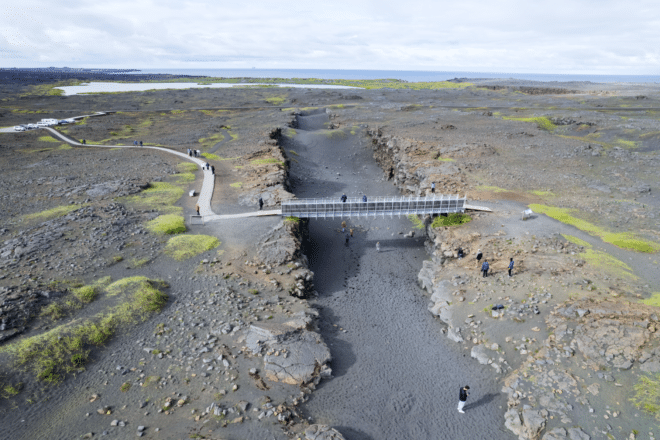
Imagine standing with one foot in North America and the other in Europe. No, you haven’t suddenly become a giant, you’re on the Bridge Between Continents. It’s a small foot bridge that spans a major chasm. And while it might not look like much at first glance, it’s actually one of the few places on Earth where you can straddle two continental plates.
The bridge is a symbol of connection, spanning the rift valley that marks the boundary between the North American and Eurasian tectonic plates. This isn’t just a walk. It’s a stroll across a geologic fault line. A journey across millennia of Earth’s shifting and shaking — a thought that should add a certain spring to your step.
The bridge stands as a testament to our planet’s constant movement and evolution. Even if we can’t feel it in our daily lives. As you cross from one side to the other, there’s a palpable sense of being part of something much larger and more powerful than ourselves. It reminds us that we’re residents of a living, breathing world, a world that shifts, grows, and evolves beneath our feet. You can’t help but feel a little humble and a lot amazed.
4. Seltún Geothermal Area
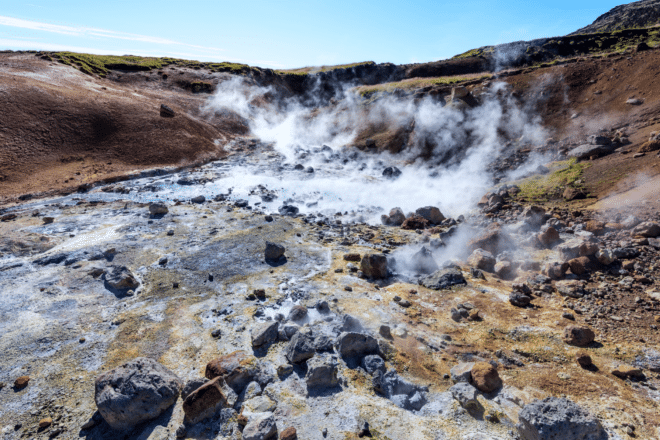
Now, if you take a journey a bit south of Kleifarvatn Lake, you’ll stumble upon a place that seems as if it’s been plucked straight out of a science fiction story. Welcome to the Seltún Geothermal Area, a vibrant and lively tableau that captures the essence of the Earth’s internal workings.
Here, nature’s palette takes a turn for the dramatic. Steaming fumaroles, hissing steam vents, boiling mud pools, and ground painted in shades of yellow, red, and green due to the presence of minerals. It’s a stark, somewhat surreal contrast to the icy landscapes we often associate with Iceland.
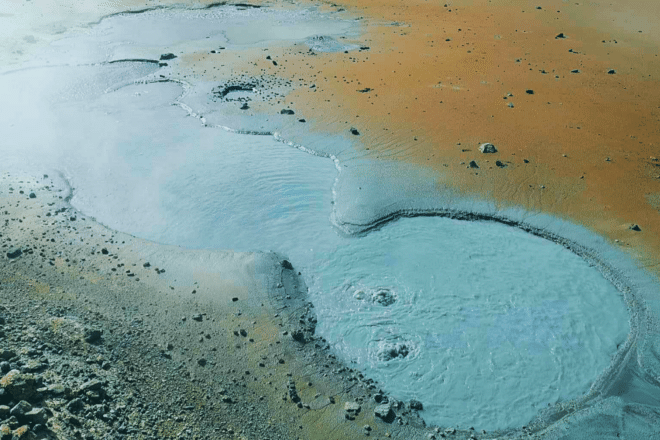
Now, close your eyes and take a deep breath. Wait, what’s that smell? It’s akin to rotten eggs or, well, farts. But before you wrinkle your nose in disgust, let me tell you it’s just good old sulfur. While not the most pleasant of odours, this distinctive smell serves as a tangible reminder of the intense geothermal activity happening beneath your feet. It’s as if the Earth is speaking to us, using its unique olfactory language, a sort of “Eau de Volcano”, if you will.
Despite the off-putting scent, there’s something oddly charming about this place. It’s a sensory experience that makes Seltún a must-visit. Capturing the grandeur, power, and, occasionally, the less glamorous aspects of Mother Earth.
5. Reykjanestá Cliffs & Reykjanes Lighthouse
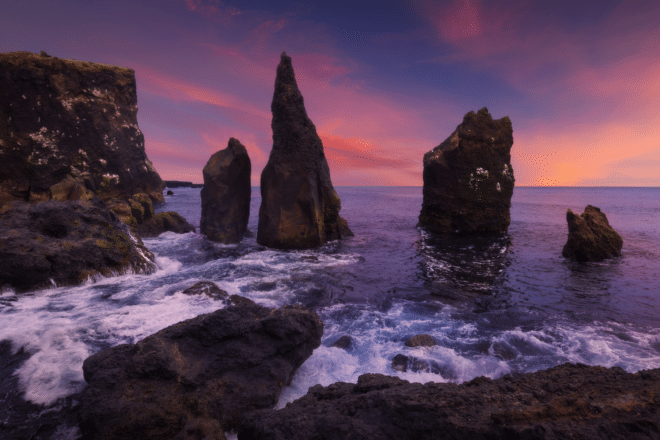
The Reykjanestá Cliffs present a mesmerizing display of nature’s raw power and endless rhythm. Each wave that crashes against these mighty rocks, each gust of the salty sea breeze, and every call of a seabird dancing on the wind, all join in a symphony of sensory delight. It’s a captivating theatre of natural forces. Here the land meets the ocean in a dramatic show that plays out each day, irrespective of the audience.
Perched on the rugged shore stands the Instagram-worthy Reykjanes Lighthouse, or Reykjanesviti. It serves as a captivating example of how our perception of beauty can be influenced by context. Its stark white exterior contrasts against the dark, dramatic backdrop of volcanic rocks and crashing waves, embodying the concept of “salience”. The ability to stand out and capture our attention.
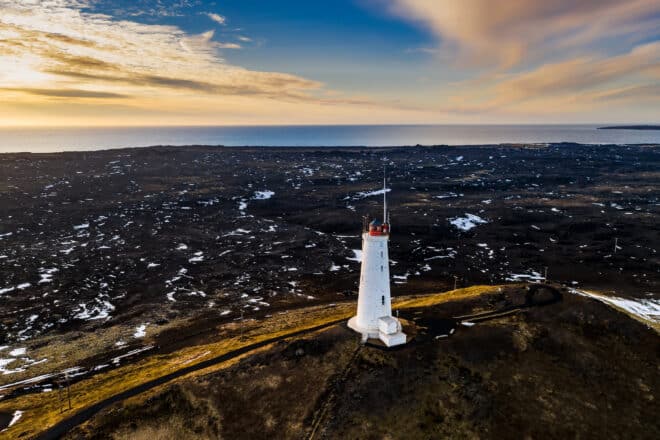
Then there’s Valahnjúkur Hill, standing nearby as if waiting for those who yearn for a higher vantage point. The climb, while not for the faint of heart, is rewarding in its own right. Every step up the path brings a new perspective. A fresh frame of the ocean’s expanse and the landscape’s rugged, yet captivating, beauty.
6. Gunnuhver Hot Spring
Close to Reykjanes Lighthouse is Gunnuhver Hot Springs, a geothermal spectacle. It is named after the ghost of Guðrún, or Gunna, adding a tantalizing layer of folklore to this natural wonder. As the tale goes, after a series of heated arguments, Gunna’s spirit was not given peace in death. Instead, she was bound to the area. And it’s said her wrath fuels the furious boiling of the hot springs here.
Visiting Gunnuhver isn’t just about witnessing the raw energy of geothermal activity or basking in the majesty of the steam plumes. It’s a journey that marries science with stories, the tangible with the intangible. It’s about feeling the thunderous power of the hot springs under your feet. Hearing the hiss of the steam. Seeing the wild dance of the boiling waters. And, all the while, picturing Gunna’s spirit amidst it all.
7. Hvalsneskirkja Church
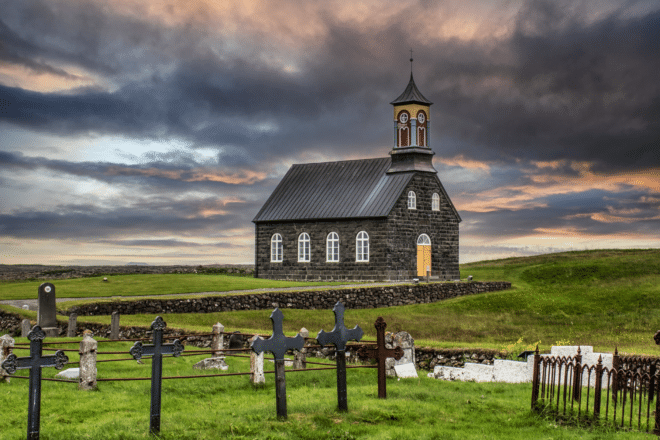
Hvalsneskirkja Church is a humble yet striking structure steeped in history and serenity, built almost entirely from local stones. Each stone, weathered by time and elements, has silently borne witness to generations of communal gatherings, ceremonies, and quiet prayers. Thus serving as a quiet chronicle of the community’s shared history and spiritual journey.
Noteworthy is one of the church’s ancient gravestones, carved in memory of Steinunn Hallgrímsdóttir. A girl who died in 1649, not quite reaching her fourth birthday. Steinunn was the daughter of famed poet Hallgrímur Pétursson, whose name is on another church, Hallgrímskirkja in Reykjavík. This deeply personal artefact adds an additional layer of depth to the Hvalsneskirkja experience. It knits together the threads of joy, sorrow, love, and faith that define our shared human experience.
8. Garður Town
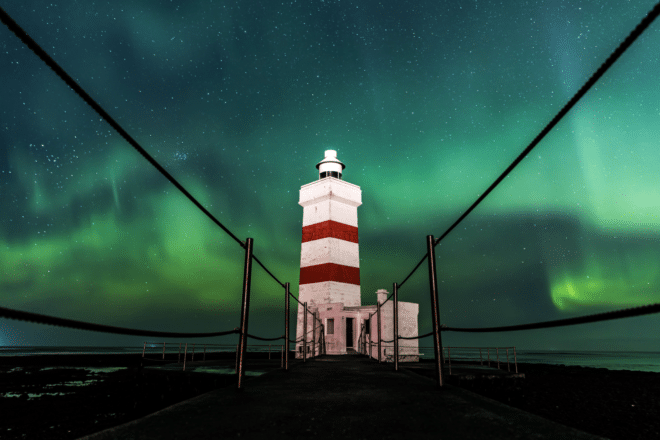
The charming coastal town of Garður is a charming retreat that offers a heartwarming blend of historical richness, natural beauty, and a pinch of whimsy. Stroll along the shore, immerse yourself in the local lore at the Folk Museum, or engage with the friendly locals. Every aspect of Garður invites you to savour a more relaxed pace of life.
Just a stone’s throw away, Garðskagi awaits, with its iconic twin lighthouses serving as guardians over the rugged shore. Together, they offer an exquisite vantage point to witness the play of light and shadow over the vast expanse of the ocean. Often, as the sun dips below the horizon in the winter, the spectacle of the Northern Lights begins. And fills the sky with ethereal, dancing colours.
9. Viking World & The Icelandic Museum of Rock ‘n’ Roll
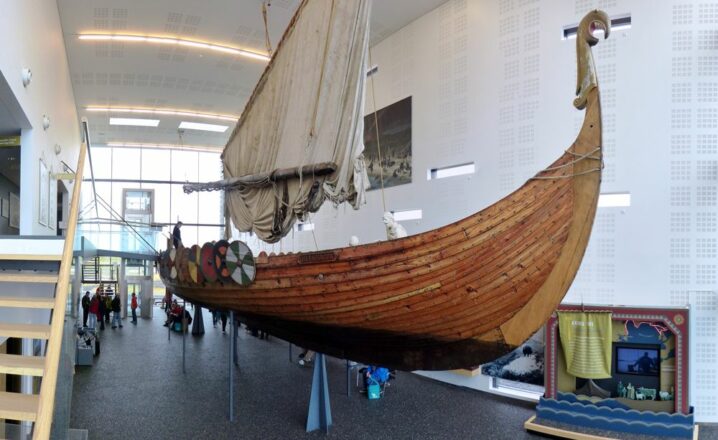
Looking for some indoor activities while visiting the Reykjanes Peninsula? The vibrant town of Reykjanesbær has two popular ones, perfect for rainy days.
The first is the Viking World Museum, a Nordic history and culture treasure trove. The highlight is the stunningly restored Íslendingur, a Viking ship that sets your imagination adrift on the icy North Atlantic alongside burly seafarers and fearless explorers. It’s an immersive glimpse into the Viking Age, where every exhibit feels like a time capsule. It transports you back to a period of grand expeditions and legendary Sagas.
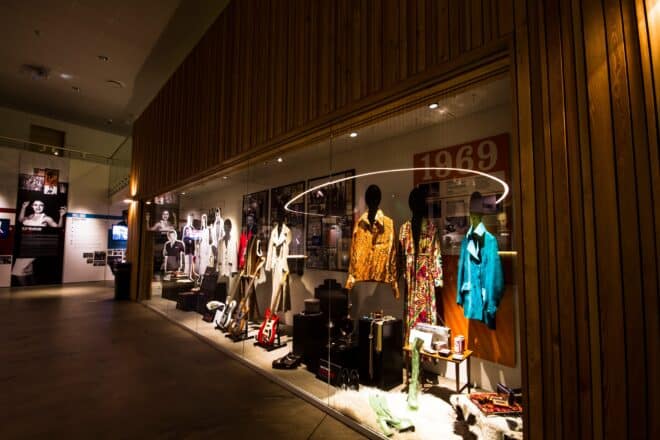
Then, on a different note – quite literally – there’s the Icelandic Museum of Rock ‘n’ Roll. This isn’t just a building full of memorabilia; it’s an electrifying journey through modern music’s rebellious and vibrant heartbeat. Each guitar, each gold disc, and each photograph echoes with the passion, creativity, and unyielding spirit of rock and roll artists. It’s a place that captures the joy and freedom of music. A place that invites you to tap your feet, bob your head, and lose yourself in the rhythm of the past.
Both the Viking World and the Icelandic Museum of Rock ‘n’ Roll offer not just a visit but an emotional and historical journey. They challenge us to consider the different ways in which human creativity and audacity express themselves. Be it through conquering unknown seas or strumming a rebellious chord.
10. Brimketill Pool
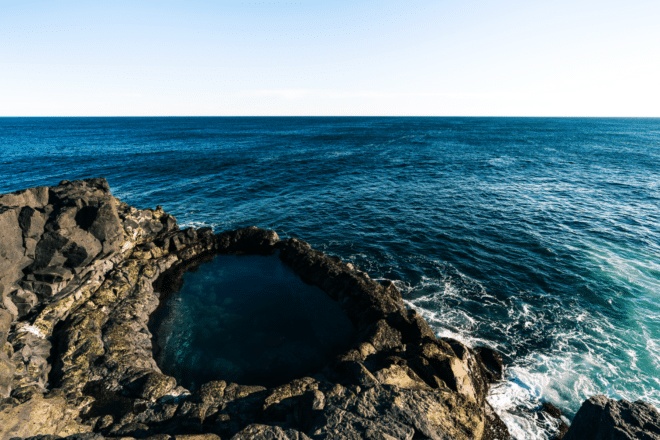
At the edge of the Reykjanes Peninsula, where the relentless waves of the Atlantic meet the rugged shore, you’ll find Brimketill – a natural wonder moulded by the tireless efforts of the sea. This peculiar formation, a natural pool carved out of lava, is a testament to the ceaseless persistence of nature, illustrating the power of incremental changes.
Brimketill is more than just a geological spectacle. It’s a compelling lesson in patience. Reminding us that even the harshest forces, when applied persistently, can result in something profoundly beautiful.
Folklore paints a more whimsical picture of Brimketill, dubbing it the bathing pool of a mythical giantess named Oddný. In the echoes of the crashing waves, you can almost hear the whispers of ancient tales, blurring the lines between reality and myth.
11. Blue Lagoon
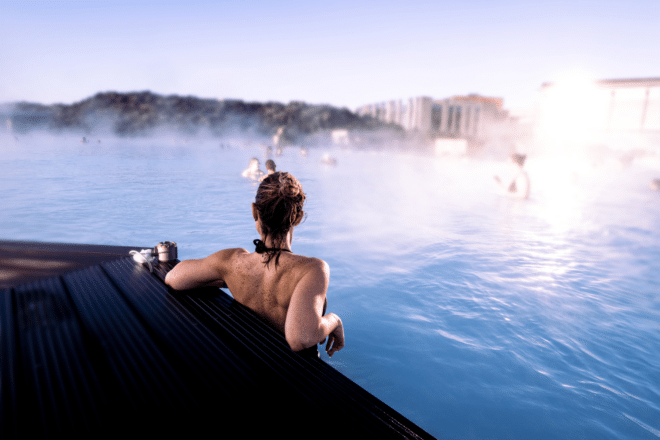
Concluding our extraordinary journey across the Reykjanes Peninsula, we find ourselves at the threshold of an ethereal wonder – the Blue Lagoon. This geothermal spa serves as an oasis that exemplifies the unique alchemy of Iceland’s geological prowess. The warm, milky-blue water, rich in minerals and enveloped in rising steam, presents a striking contrast against the rugged black lava field surrounding it.
The lagoon is more than just a geothermal spa. It’s a testament to innovative thinking and human ingenuity. Transforming the byproduct of a geothermal power plant into a world-renowned wellness destination. It’s an embodiment of the concept that beauty and utility can coexist harmoniously. And that progress and preservation are not mutually exclusive.
Located midway between Reykjavík and Keflavík Airport, the Blue Lagoon often becomes the last stop on a traveller’s journey in Iceland. And it perfectly encapsulates the essence of the island – its unyielding geological powers, spellbinding landscapes, and resourceful spirit.
Map of the Reykjanes Peninsula’s Top Places
Summary
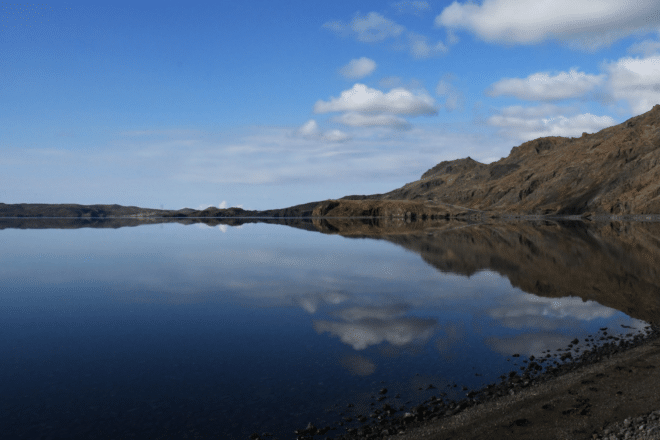
The Reykjanes Peninsula, a hidden gem of Iceland, offers an enchanting blend of geological wonders and cultural heritage. Its stunning landscape is characterized by geothermal areas like the Blue Lagoon, rugged volcanic cliffs, and lava fields. Alongside its natural beauty, the peninsula houses historical sites and fishing villages that reveal Iceland’s Viking past.
Its unique geographical positioning on the Mid-Atlantic Rift, between the Eurasian and North American tectonic plates, results in frequent volcanic and geothermal activities. The continuous divergence of these plates gives rise to hot springs, steam vents, and recurring volcanic eruptions, such as the 2021 – 2023 eruptions near the Fagradalsfjall Volcano.
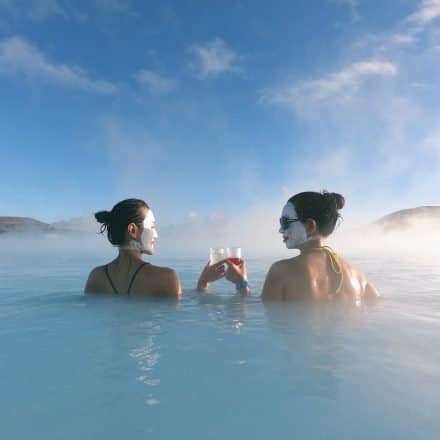
Visitors can witness the peninsula’s raw beauty at various spots, like the Fagradalsfjall Volcano Eruption Sites, which recently came back to life after centuries of slumber. Kleifarvatn Lake, the largest on the peninsula, enchants visitors with its ever-changing colours and tranquil environment. The Bridge Between Continents, which offers a unique experience of straddling two tectonic plates.
Other stops include the geothermally vibrant Seltún Hot Springs, the visually stunning Reykjanestá Cliffs and Reykjanes Lighthouse, and culturally rich locations like Hvalsneskirkja Church and Garður Town. The Gunnuhver Hot Springs carry the legend of the ghost Gunna, adding a touch of folklore. Lastly, visitors can learn about Viking history at the Viking World Museum or enjoy the rhythm of the past at the Museum of Rock ‘n’ Roll.

